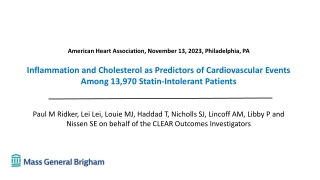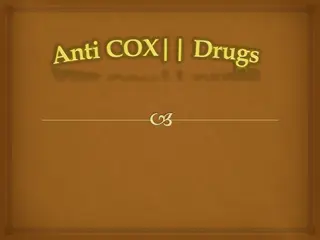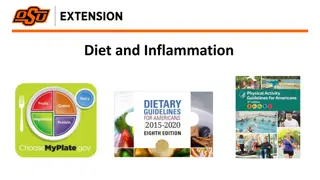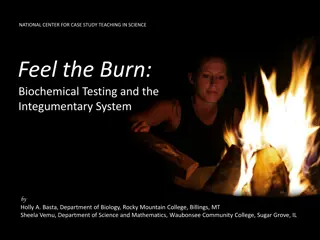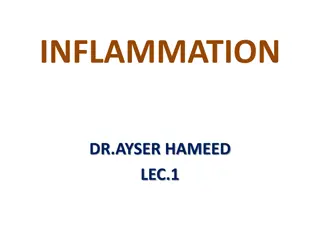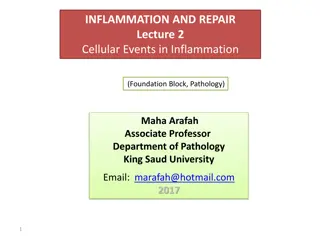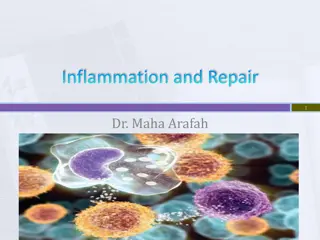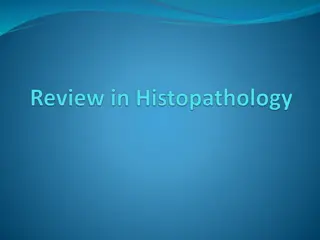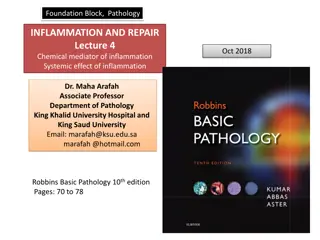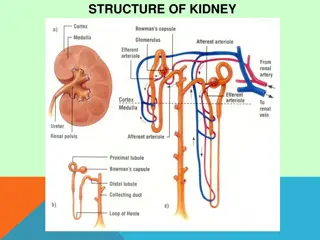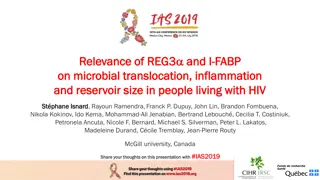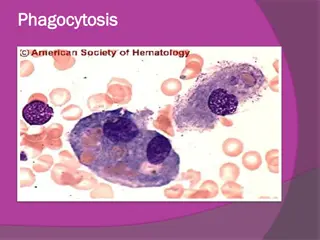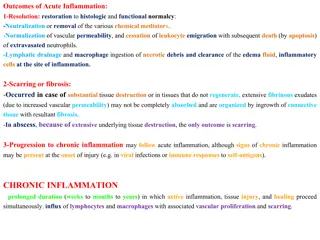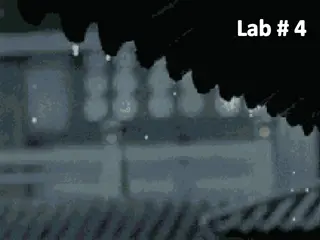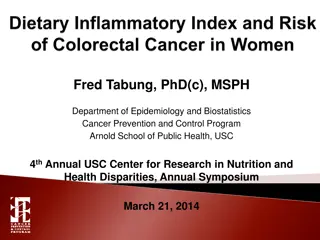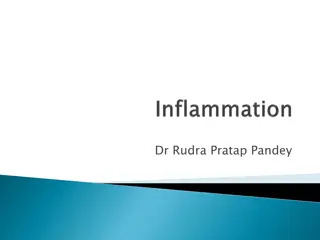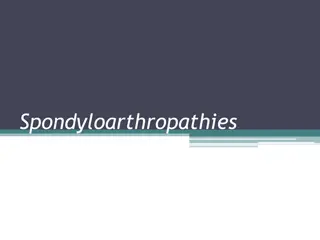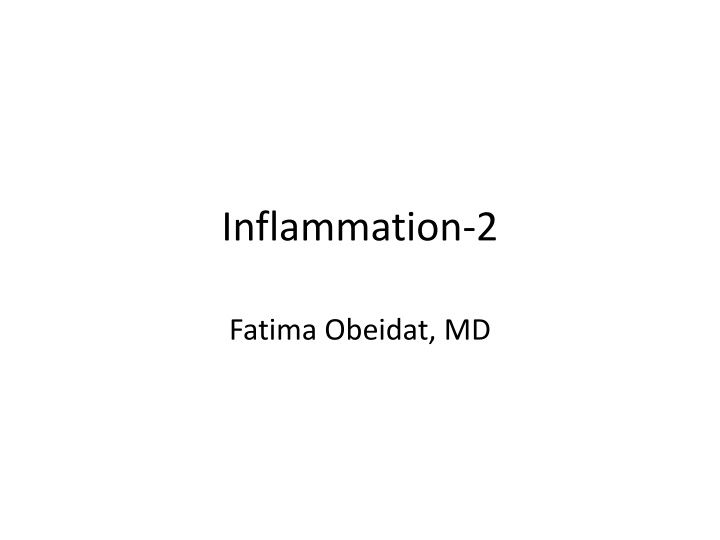
Leukocyte Cellular Events in Inflammation
Explore the intricate cellular processes involved in inflammation, including leukocyte margination, rolling, adhesion, and transmigration. Learn about the key mediators and mechanisms that drive these crucial immune responses within the body.
Download Presentation

Please find below an Image/Link to download the presentation.
The content on the website is provided AS IS for your information and personal use only. It may not be sold, licensed, or shared on other websites without obtaining consent from the author. If you encounter any issues during the download, it is possible that the publisher has removed the file from their server.
You are allowed to download the files provided on this website for personal or commercial use, subject to the condition that they are used lawfully. All files are the property of their respective owners.
The content on the website is provided AS IS for your information and personal use only. It may not be sold, licensed, or shared on other websites without obtaining consent from the author.
E N D
Presentation Transcript
Inflammation-2 Fatima Obeidat, MD
Leukocyte Cellular Events Margination, rolling and adhesion. Transmigration between endothelial cells. Migration in the interstitium toward the site of stimulus (chemotaxis and activation) Phagocytosis and degranulation (Release of leukocyte products.)
Rolling, adhesion, and transmigration are mediated by the binding of complementary adhesion molecules between leukocytes and endothelial surfaces. Chemical mediators (chemoattractants) affect these processes by modulating the surface expression of the adhesion molecules and by stimulating directional movement of the leukocytes.
Mediators : Selectins in rolling. Chemokines in activating the neutrophils to increase surface affinity of integrins. Integrins in firm adhesion. CD31 (PECAM-1) in transmigration
1- Margination and Rolling Leukocyte accumulation at the periphery of vessels is called margination. Leukocytes transiently stick loosely to endothelial surface, along the way, this is called rolling. This weak and transient adhesion is mediated by the selectin family of adhesion molecules.
a.Margination As blood flows from capillaries into post capillary venules, circulating cells are swept by the laminar flow against the vessel wall The smaller red blood cells tend to move faster than leukocytes As a result , the leukocytes are pushed out of the central axial column and thus have a better opportunity to interact with the endothelial cells
Rolling mediated by Three types of selectins E-selectin : on endothelial cells P-selectin : on endothelium and platelets L-selectin : on surface of most leukocytes
b.Rolling Is mediated by selectins Selectins bind sialyated oligosaccharide(their ligands) 1. The endothelial selectins are typically low expressed or not expressed at all on normal cells, therefore binding of leukocytes is largely restricted to endothelium at sites of inflammation or injury
E. Selectin which is not expressed on normal endothelium is induced by TNF and IL-1 to bind leukocytes
2.p-selectin is present in intracellular wiebel- palade bodies and within minutes of exposure to mediators such as histamine p-selectin is distributed to the cell surface where it can facilitate leukocyte binding
2- Firm adhesion Integrins on leukocytes and their ligands on endothelial cells. Normally expressed on leukocytes membranes in a low-affinity form. Adhere to their ligands upon activation by chemokines.
Ligands for integrins on endothelial cells ICAM-1 (intercellular adhesion molecule 1) binds integrin LFA1 and MAC1 VCAM-1 (vascular cell adhesion molecule 1), binds integrinVLA4 IL-1 and TNF increases their expression. The net result is stable adhesion of leukocytes to endothelial cells at sites of inflammation.
3- Transmigration of leukocytes Squeezing between cells at intercellular junctions (Diapedesis). Mediated by PECAM-1 (platelet endothelial cell adhesion molecule 1, also called CD31). Collagenases to degrade the BM.
4- Chemotaxis Migration of leukocytes toward site of inflammation Exogenous and endogenous chemotactic factors: (1) bacterial products, particularly peptides with N- formylmethionine termini (2) cytokines, especially those of the chemokine family like IL-8. (3) Complement system, particularly C5a (4) products of the lipoxygenase pathway of arachidonic acid (AA) metabolism, particularly leukotriene B4(LTB4)
Nature of leukocyte infiltrates in acute inflammatory reactions Neutrophils predominate in the inflammatory infiltrate during the first 6 to 24 hours and are replaced by monocytes in 24 to 48 hours. Neutrophils are short-lived-they die by apoptosis and disappear within 24 to 48 hours-while monocytes survive longer.
5-Leukocyte Activation Needed to perform their function. Leukocytes express on their surface different kinds of receptors that sense the presence of microbes, dead cells and foreign substances such as toll-like receptors Engagement of these receptors induces responses in leukocytes to perform defensive functions.
Leukocyte activation 1- Phagocytosis of particles, an early step in the elimination of harmful substances. 2-Intracellular destruction of phagocytosed microbes and dead cells; using lysosomal enzymes and reactive oxygen and nitrogen species. 3-Liberation of substances that destroy extracellular microbes and dead tissues (microbicidal) 4- Production of mediators that amplify the inflammatory reaction, including arachidonic acid metabolites and cytokines.
Phagocytosis Ingestion and digestion by cells of solid substances, e.g., other cells, bacteria, necrotic tissue or foreign material. Steps : Recognition, and receptors. Engulfment. Phagocytic vacoule. Phagolysosome. Killing ingested material. attachment to cellular binding or degradation or
Recognition first: By specific surface receptors for: 1-Components of microbes (LPS) 2-Dead cells 3-Host proteins (opsonins) that coat microbes and target them for phagocytosis ( A. IgG class, B.C3 products, C.Collectins
Opsonin Receptors Receptors IgG: Fc Gamma R Receptor for C3b: CR1-3 Receptor for collectins is c1q
In engulfment, psedopods are extending around the object eventually forming the phagocytic vacuole The membrane of the phagocytic vacuole fuses with the lysosomal granules forming the phagolysosome
Killing of Infectious Agents Oxygen burst products (free radicals, leukocyte oxidase) Lysosomal enzymes (elastase, acid hydrolases) Bactericidal permeability increasing protein lysozyme Major basic protein (in eosinophils) Defensins
Reactive oxygen species Produced by NADPH oxidase produces superoxide ion. Superoxide converted by spontaneously to Hydrogen peroxide. Hydrogen peroxide converted to HOCL radical by neutrophil myeloperoxidase. .

